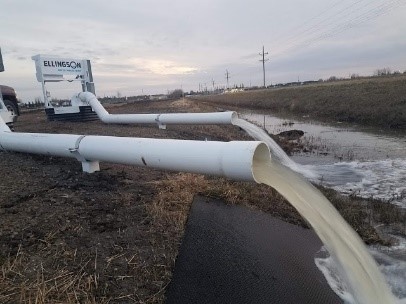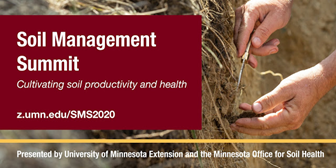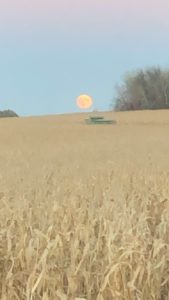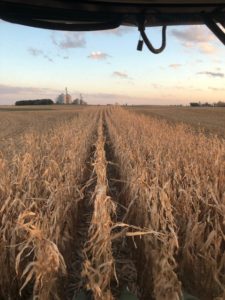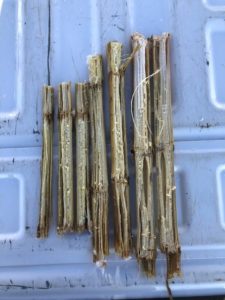Your Local Weekly Ag Partners Agronomic Update.
The one-stop-shop to hearing everything you need to know this week about what is happening in your fields.
This week’s featured agronomists are:
Austin Schultz- LeCenter
Justin Schaefer – Wanamingo
Tyrell Treptow – Goodhue
Brett Decker- Lewiston
Brady Kinneman- Ellsworth
Scroll down to hear from your local agronomist.
West
Belle Plaine – LeCenter – LeSueur
|
Austin Schultz |
Happy Fall to all! Here in Le Center, we are wrapping up our final fall fertilizer applications and saw a tremendous increase in the amount of dry fertilizer we spread this fall over previous years. We also saw a sizeable increase in anhydrous ammonia applications- all bettering our workload for next spring. I was very happy to see record yield numbers for quite a few of my growers on both corn and beans. |
There were areas where crops performed more like normal, and typically those were more related to a severe weather event more than anything else. It is important to remember that with every bushel you pull out of the field, a substantial amount of nutrients are carried away with it. Typically, we plan to fertilize for more of an average year, but with bin-buster yields like this year, it is evident that higher amounts of nutrients were removed. It will be critical to adjust for these higher yields in your next fertilizer application or you will have a chance of shorting yourself a year or two down the road. With our 2020 growing season coming to an end, I think now is the perfect time to rest and reflect. The year may have gone by like a whirlwind with many different hardships to deal with, not only on the farm but in public as well. When planning for 2021, it will be very important to take a deeper dive into your operation to really see what worked and what did not. While making some of these decisions, instead of just comparing what worked on your best acres, I also urge you to take a deeper look into what did best on your poor acres. Usually, that is where we can make the largest improvements to your bottom line. I think in order of importance, growers should consider the following in order:
- Tiling– getting the water away will add the largest benefit to your bottom line, we see this consistently year over year
- pH– adjusting your pH to proper levels are a surefire way to improve each acres nutrient uptake capabilities
- Fertility– managing your fertility should come after the first two, instead of just throwing more fertilizer at a problem, I argue it is more important to fix #1 & 2 first, in order to see exponential gains on the fertility in the ground as well as applied
- Seed– Seed choices are very important and it is important to purchase what is best fit for each acre on your farm. Price is always a component, but if there is a variety that can consistently out yield others on your operation, that usually has the largest return on investment you will see
- Chemical Programs– Weed control is huge, there are many different companies and programs to choose from but selecting the right one for you can be very difficult. Ask your agronomist for advice
These are not the only things that can change the look of your farm, but they are a great start. Completely understanding all your options for each of these different cases will be a great start in the right direction. As always, all of us here at Ag Partners thank you for your business and look forward to partnering with you for a profitable future. If it weren’t for the farmer, there wouldn’t be a cooperative.
Central
Wanamingo – Kenyon – Morristown – Owatonna
|
Justin Schaefer |
Our Indian Summer showed up last week just in time to help many of our area growers finish up their corn harvest. With corn moistures already in the upper teens, drying corn a few points is much more fun with mid 70 degree temperatures! Corn yields were quite good in our area again this year with many field averages landing in the 215 to 250 bu/acre range. |
Yes, the weather played a big role in both our good corn and bean yields this year but fertilizer, fungicide, and correct hybrid placement are also driving us to averages we have not seen much before. Our precision team is currently putting together information on all of this, so please talk with your agronomist this winter when going through your crop plans for 2021 to discuss how we can maximize your ROI.
We also had a good run on anhydrous, dry fertilizer and lime spreading in our area. Hopefully Mother Nature will allow us to get back out there more in the next few weeks, but you never know this time of year. As many of you are probably aware there are restrictions on fall nitrogen placement now, so please reach out with any questions.
Please continue to stay safe while finishing things up this fall!
South
Lewiston
|
Brett Decker |
What a year 2020 has been. The ups and downs we endured throughout the growing season did not leave us with disappointing yields this fall. From early plantings, to excessive heat, and a little drought in some areas, the crop performed better than anticipated for most growers. |
Like most of 2020, whether it be the pandemic we are in or what Mother Nature throws at us, things seem to change very quickly. After a record-breaking streak of 70-degree weather this past week, most growers in the area were able to finish harvest. With the help of excellent weather, yields, and grain prices- we have seen a big demand for growers to apply lime and fertilizer this fall.
As we finish the 2020 crop season, please remember to finish those report cards for each farm and/or the variety of corn or soybeans. It is important to make excellent notes now so as you sit down with your agronomist this late fall and winter, we can determine what worked excellent and what did not work so well. It will also help with defining the zones within each field and placing the right seed on the right acre. Also do not forget where and how bad the weed patches were so we can get the correct chemical program in place for 2021, to try to eliminate the bad escapes from previous years. As always keep in touch with your local Ag Partners agronomist on all your needs.
East
Pine Island – Cannon Falls -Goodhue -Lake City
|
Tyrell Treptow |
Mark Your Calendars! |
Agricultural Drainage Research Event
Learn about the latest agricultural drainage research at the 2020 Drainage Research Forum on Tuesday, December 1. The event is free and will take place on Zoom.
https://blog-crop-news.extension.umn.edu/2020/11/free-online-event-on-agricultural.html
2020 Soil Management Summit (Formerly Conservation Tillage Conference)
Online Event: Tuesday, December 15 – Wednesday, December 16
Some of this year’s topics include tillage erosion, soil organic matter and water dynamics, and the conference staple – a panel of farmers sharing their own personal experiences with soil management
https://extension.umn.edu/event/2020-soil-management-summit
13th Annual Nutrient Management Conference
University of Minnesota Extension and the Minnesota Agricultural Water Resource Center’s Nutrient Management Conference will be virtual this year and take place on February 16, 2021
Past sessions included research topics, nutrient reduction strategies, and the latest research on nitrogen, phosphorus and potassium fertilization
https://extension.umn.edu/courses-and-events/nutrient-management-conference
WWAS
Ellsworth
|
|
This last week’s Indian summer gave opportunity to make a big impact on harvest. Harvest in Wisconsin is nearing the end. Farmers have applied fertilizer, completed tillage, and while it was 70 plus degrees washed equipment and nestled them in the sheds for winter. I had several farm visits this week while growers were enjoying the great weather. I even had to bust out a cut off tee shirt last week to even out that tan for Thanksgiving! Obviously, today we went back to reality- but hey, at least the grain market is on the up and up. |
Overall, yields have been above average. I have had calls over the last week how corn-on-corn fields have not been consistent on yield. Its not too late to scout fields for stalk and crown rot. I have witnessed a fair amount Fusarium and Crown Rot in fields that are already combined. Get out in your fields with your agronomist this fall and scout disease issues. Keep in mind planting date, tillage soil moisture, overall moisture during the year, and starter practices. Try to make correlations based on management practices to find what worked and what didn’t work. Fields that were planted early to mid-April had uneven emergence due to the cold late April and it shows up on the yield monitor.






